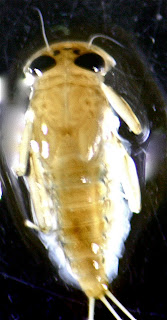The "Flatheaded" mayfly is the one nymph that samplers can count on seeing in almost every sample they do in our watershed: no matter where the stream is, no matter what time of year. And the genus we see most often is the one in the photo above -- Stenonema (Maccaffertium). However, we have at least six Flathead genera in our streams in this part of Virginia, and in this entry I will describe the six that I've seen and provide photos of the features used in identification.
[But first a word of caution to my fellow fly fishing friends. Our much loved mayfly Stenonema (Stenonema vicarium = March Brown; Stenonema fuscum -- Grey Fox; Stenonema canadensis and ithaca = Light Cahill) -- now has a new name. The professional entomologists have changed this to genus Maccaffertium. That they did this without consulting with fly fisherman is simply rude and unthinking! (Just joking, of course.) Don't they realize how many fly fishing books are now hopelessly out of date?! Well, I am here to say I'm a fly fisherman first and an entomologist second (and a rank amateur at that!). So, in this little essay the old Stenonema is still Stenonema (the pros -- are they really reading this?!) will surely be disappointed that I'm so behind the times.]
The six Flatheaded genera we have in our streams -- well, the six I have seen -- are Stenonema, Stenacron, Epeorus, Rhithrogena, Heptagenia, and Leucrocuta. These are best discussed in pairs (each pair has similar gills), so we will look at Stenonema and Stenacron, then Epeorus and Rhithrogena, and finally Heptagenia and Leucrocuta.

 The genera Stenonema and Stenacron were once lumped together as a single genus, but they are now treated as two based on the different shapes of gills 1-6. Gills on abdominal segments 1-6 on Stenonema nymphs are "truncated" (squared off); those on Stenacron nymphs come to a point. See the photos left (Stenonema) and right (Stenacron).
The genera Stenonema and Stenacron were once lumped together as a single genus, but they are now treated as two based on the different shapes of gills 1-6. Gills on abdominal segments 1-6 on Stenonema nymphs are "truncated" (squared off); those on Stenacron nymphs come to a point. See the photos left (Stenonema) and right (Stenacron).The gill on the 7th abdominal segment is the same on both genera. It is thin, finger-like, and angles out from the abdomen (gills 1-6 overlap one another and hang down on the sides of the abdomen. The photo below of the ventral side of a Stenonema nymph will clarify the point I'm trying to make.
The genus Epeorus has been discussed in a previous entry ("The North Fork of the Moormans: Return of the Epeorus") with the focus on its large, disc-like gills that function like "suction cups".
Rhithrogena nymphs initally look much the same, with similar gills, but they have three tails, not two, and their gills extend in a complete oval on the ventral side of the insect. The sole photo I've done of Rhithrogena is not very good, but it will have to suffice.
Like its sister nymph this one lives in cold, clean, fast flowing waters and can hold on to the rocks with great suction given that full circle of gills.
Heptagenia and Leucrocuta nymphs have gills that look quite different than these. With these genera, gills on abdominal segments 1-7 are all shaped the same (the one on gill 7 might be a little bit smaller), and they tend to angle out from the body. Here is a photo of a Heptagenia nymph.
And let me add a close-up of some of those gills. The gills on segments 3-7 are clearly visible on both sides of the nymph, and take note of the "feathery" fibers behind each gill (technically called fibrilliform).
Leucrocuta nymphs differ from Heptagenia nymphs by lacking fibrilliform behind gill number 7. Here is a photo of a Leucrocuta nymph, followed by a close-up of its gills.
Leucrocuta nymphs are very, very small. I saw them all summer long, and they never got any bigger.
Also note that the head looks way too big for the body. Thus, although there is little that separates Heptagenia and Leucrocuta nymphs in dichotomous keys, in physical appearance they are quite distinct.
Not all of our streams have all these genera. In fact, I would not be surprised to find that in most of our streams the only genus you'll find is Stenonema -- and you'll find it every month of the year. My impression -- and that's all it is, an impression -- is that the better the stream, the more genera it holds in the course of the year. While Stenonema nymphs seem to be present all year, the other genera are "seasonal," i.e. only around for part of the year. I've found Epeorus nymphs -- in the waters that support them -- present in large numbers from January through May (with the odd few showing up through the month of July). Rhithrogena nymphs I've only seen in April and May (that's not to say those are the only months they are present). I've found Stenacron nymphs in only two streams; that was in May in one stream, July in the other. Leucrocuta and Heptagenia, I think, are summer nymphs: I found them over and over again in the months of July and August. The most genera I've found in a single stream is four: Stenonema, Epeorus, Rhithrogena, and Leucrocuta (Buck Mt. Creek). But I cannot claim to have studied this systematically.
For "live" photos of the nymphs above, please see the entry on 4/26/11. (Below: another Stenonema nymph.)









No comments:
Post a Comment